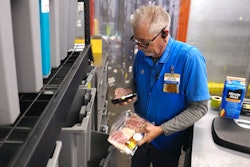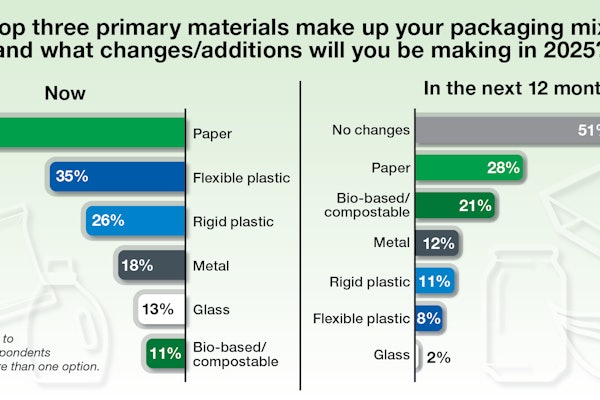Throughout the summer of 2024, a video advertisement has been airing regularly on national networks, cable channels, and the internet. The target audience is consumers of products that use plastics, including packaging. In fact, throughout its 30-second duration, there is not a time when packaging is not shown. By extension, CPG companies have a vested interest in the ad’s message and its effectiveness.
At its start, the ad shows various types of crumpled post-consumer packages, aligned and depicted in grayscale. A pointing index finger pushes the first package, toppling it and triggering a domino effect. The toppled packages don’t remain down, however. They spring up, transformed, vibrantly colored and perfectly shaped. The domino effect travels along, making an arrowed circle. Inside that circle is “MAKING SUSTAINABLE CHANGE” and wrapped along its bottom is “AMERICA’S PLASTIC MAKERSSM.
The ad’s message is delivered by this voiceover:
“Imagine a future when plastic is not wasted but instead remade over and over into the things that make our food fresher, our families safer, and our planet cleaner. To help us get there, America’s Plastic Makers are investing billions of dollars to create innovative products and new recycling technologies for sustainable change, cause when you push for smarter solutions, big things can happen.”
The ad’s sponsor is the American Chemical Council (ACC), a trade group. Its Plastics Division’s membership is a who’s-who list of industry giants. Since plastics see a wide diversity of uses, the ad’s focus on packaging is not by accident. Of those uses, packaging is the one that is ever-present in consumers’ lives, comprising a more-than-modest percent of household solid waste.
Plastic packaging has had its sustainability bona fides challenged more than has any other packaging material. The long-standing list goes as follows: (petroleum-based) plastics are derived from a non-renewal resource, they can last for centuries even in landfill, and they pollute oceans and waterways. The challenges continue to grow, including the allegation that our bodies have been invaded by various chemicals derived from plastic packaging. Critics have lumped challenges and allegations to portray plastics as an existential threat.
The ACC is aware of the mounting attacks against plastics in general, and against plastic packaging in particular. It also is aware of the increasing variety of ways that critics are communicating their attacks to the public. Given such headwinds, it’s fair to describe the ACC’s ad as public relations. Since all public relations are attempts at persuasion, their effectiveness depends on their credibility.
CPGs, despite not being the target audience, should evaluate the ad against the standard of credibility. The Plastics Division’s membership includes oil companies, refineries, resin producers, and packaging suppliers—all of which are upstream in the supply chain. CPGs are downstream, the last stop before goods end up in the hands of consumers. Because of that proximity, CPGs can’t isolate themselves from public complaints about plastic packaging. It follows, therefore, that CPGs companies stand to be affected by the promises and expectations set by upstream public relations.
The ad contends that sustainability can be achieved via recycling technologies that are fueled by investments and innovations. Sounds good, but sceptics will have their say. The major plastics used for packaging are inherently recyclable, a characteristic that has been promoted dating back to the 1980s, when the chasing-arrows symbols came into use. So at least two generations of consumers have reached adulthood having been lectured that recycling is a civic responsibility. Today, recycling rates remain mired in the 10% (or lower) range [overall]. If the ad is interpreted as intimating that greater recycling rates loom, then that’s a low bar to clear, lacking additional specificity.
An oft-cited reason for low recycling rates is a lack of infrastructure. The association between the two needs to be evaluated in the right context. Even if present infrastructure can’t support a robust increase in recycling, it doesn’t necessarily follow that present infrastructure is at capacity. If it’s not at capacity, additional factors likely are at play. One of them can be that, under capitalism, an infrastructure of the private variety (vs. public) needs a profit motive. Will that reality be addressed by the initiatives mentioned in the ad?
An absolute necessity for the successful recycling of plastic packaging is public participation, both individually and collectively. In its essence, recycling is a grassroots undertaking, so participation needs to be incentivized. That said, what’s more effective, carrot or stick? Plastic packaging provides convenience, acknowledged by consumers’ purchases. Recycling, on the other hand, requires effort, which is an inconvenience evidenced by low participation rates. Will the seeming paradox between convenience and inconvenience be addressed by the initiatives mentioned in the ad?
This column is not intended to cast aspersions on the motives of the ACC, nor is it meant to predict the outcomes of its ad. One intention, however, is to underscore that the interests of upstream parties and downstream parties might coincide in certain regards and diverge in others. CPGs need to be alert to the challenges and allegations coalescing against plastic packaging to formulate strategic responses. Next month’s column will look into how to accomplish this.
Sterling Anthony, CPP, consults in packaging, marketing, logistics, and human-factors. A former faculty member at the Michigan State University School of Packaging, his contact info is:100 Renaissance Center, Box-176, Detroit, MI 48243; 313/531-1875; [email protected]


























